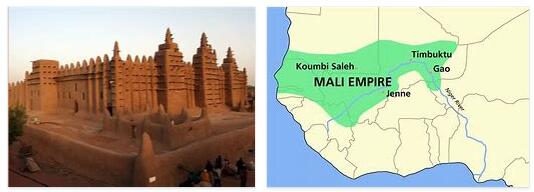Since ancient times the region was crossed by caravan routes directed towards Morocco and Algeria, while towards 700 AD. C. the black-African dynasty of the sisē asserted itself, giving splendor and power to the empire of Ghana, then attacked and conquered in 1076 by the Almoravids. Among the kingdoms that became independent at the time of the collapse of Ghana, the empire of Mali stood out. Arab-Berber travelers and chroniclers left detailed descriptions of the successive kingdoms, on the territory of Mali, between the sec. VIII and XVI and it seems that in the first decades of the century. XVI also the Portuguese had established contacts with those regions reaching as far as Tombouctou; the latter and the city of Djenne became flourishing centers of Islamic trade and culture during this period. After the Moroccan conquest of the Songhai empire in 1591, a period of political chaos followed, the Moroccans dispersed the manuscripts of the libraries of Tombouctou and interrupted the trans-Sharian ways by identifying new routes for the transport of gold and slaves. The Moroccan kingdom lasted for about two centuries, after which the Bambara kingdoms of Ségou and Kaarta were established and maintained a certain efficiency until the beginning of the century. XIX. The European explorations, started in that area from Mungo Park (1795) and continued by Barth and Caillié (which reached Tombouctou in 1828), prepared the French penetration. This found a serious obstacle first (1850-64) in the resistance of the marabout tekrur El Hadj ‘Umar and then in the even more obstinate resistance of his son Ahmadou who had established his control over the whole territory. Another fierce opponent of France was Samory Touré who in 1872 established a large kingdom on the left bank of upper Niger and resisted the advancing French columns until 1898, the year of his capture in Guélemou.
According to remzfamily, the following year, France organized the colony of Upper Senegal-Niger, including the territory of what would become – with the new political-administrative organization of 1919 – the colony of French Sudan. With the Constitution of 1946 the latter became one of the overseas territories of Loi Cadre of 1956 to proceed further on the level of political evolution. With the advent of the Fifth Republic in France and with the constitutional referendum of 1958, Western Sudan opted for the status of an autonomous Republic within the French Community, giving itself a first government and a first Constitution (January 23, 1959). In this same year Western Sudan and Senegal formed the Federation of Mali, which gained full independence on June 20, 1960. With the dissolution of this Federation (August 20, 1960), the two countries resumed their autonomy and Western Sudan assumed the name of Republic of Mali outside the French Community, giving itself a new Constitution (22 September 1960). He played a decisive part in the political life of Mali Modibo Keita, who first held the office of president of the Federation of Mali and then of the Republic of Mali. A military coup, however, put an end, on November 19, 1968, to his presidential regime: Moussa Traoré he assumed (1969) the positions of head of state and head of government and passed a new Constitution (1974) which provided for the establishment of a one-party regime. The turning point was both political and economic. At the top of the party (Democratic People’s Union of Mali), founded in 1979, was Traoré himself, who established a political system even more despotic than the previous one. Under his government in December 1985 the border dispute with Burkina Faso, determined by the dispute over the mineral deposits (of manganese) in the Agacher belt, turned into a brief armed conflict at the end of which (January 1986) the question was invested International Court of Justice in The Hague. Discontent with economic difficulties and widespread corruption in the public administration, Amadou Toumani Touré (March 26, 1991). A democratization process was then started which saw as a first act the reintroduction of multi-partyism and the proclamation of a National Conference for the definition of the political-institutional structure. A coup d’état foiled (July 1991) against the provisional government of Touré and approved with the referendum of 12 January 1992 the new Constitution introducing democratic institutions, parliamentary elections were held in February-March 1992, won by the Alliance for Democracy of Mali, followed in April by the presidential elections, won by Alpha Oumar Konaré, leader of the same party, who took office on June 8, 1992. The new leadership also proceeded to liquidate the symbols of the old regime, prosecuting the former dictator Traoré who was sentenced to death along with some of his collaborators (February 1993); but the development of the democratization process was nevertheless complicated and the difficult economic situation caused the intolerance of the youth population with the explosion of a dramatic protest in the capital Bamako (April 1993). This led to a phase of instability of the political framework characterized by reshuffles at the top of the government and the resumption of guerrilla activity by the tuaregh in the north of the country, to stem it, President Konaré sent the army and favored the formation of a counter-guerrilla force: the Patriotic Front of the Ghanda Koy.
The combination of the military initiative and the resumption of a negotiation dialogue on the basis of the national pact allowed the progressive easing of the pressure of the Tuaregh who laid down their weapons, burned in large quantities in an emblematic “bonfire of peace” held in Tombouctou in March 1996, thus making it possible for tens of thousands of Tuaregh refugees from Mauritania, Algeria and Burkina Faso to return to Mali. Postponed several times due to organizational difficulties and characterized by low popular participation, as well as boycotted by the main opposition forces, in 1997 presidential (May) and legislative (July-August) elections were held in the country, which confirmed Konaré and the Alliance for Democracy of Mali in power. Even the presidential elections of May 2002 were carried out with difficulty, due to numerous organizational problems. Konaré, ineligible after completing the second term, left the field free to other candidates and the polls awarded, surprisingly, Lieutenant Colonel Touré, former head of state from 1991 to 1992, who got the better of Soumaila Cissé, representative of the Alliance for the Democracy of Mali. In the presidential elections held in April 2007, Touré was elected for the second term. In 2010 Mali, Mauritania, Algeria and Niger they set up a coordination structure to combat organized crime and terrorism. In 2012, the Tuareg tribes of the country unleashed a new offensive, despite the peace talks between the rebels and the central government underway in Algiers; in March, the discontent of the army produced a coup that brought to power a group of soldiers led by Captain Amadou Sanogo, condemned by both the international community and the country’s political forces. The Tuareg rebels, of Islamic religion, taking advantage of the unstable political situation, conquered the whole north of the country. After a few rounds of negotiations, the military junta in power decided to appoint Cheik Modibo as premier. In January 2013, France intervened in the conflict between the government and Islamic rebels, sending a military contingent.









